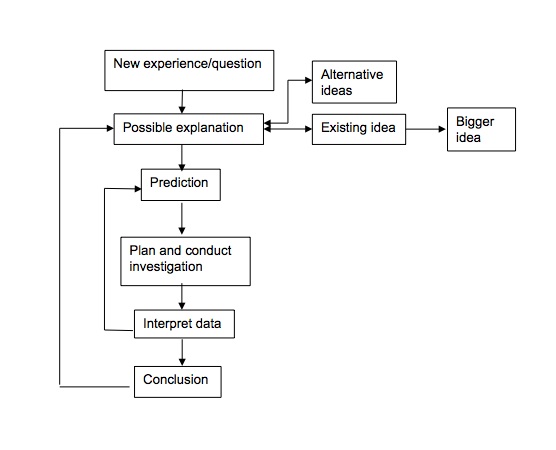Scientific inquiry
Scientific inquiry as a pedagogy involves students progressively developing key scientific ideas through learning how to investigate. In this way, students build their knowledge and understanding of the world around them through the process of inquiry. Although sometimes described as discovery based learning, this isn’t the case. The article below by Kirschner et al. (2006) is a good summary of the potential problems associated with an unguided, inquiry approach (this critique is responded to by Hmelo-Silver et al. 2007)). That said, that are some strong motivational reasons why you might like to do some inquiry with your students and there are many ways in which scientific inquiries can be structured. What’s important is to think about what guidance and prior knowledge students will need in order to inquire in a meaningful way.

Elements of an inquiry approach
During an inquiry, students use skills employed by scientists such as raising questions, collecting data, reasoning and reviewing evidence in the light of what is already known, drawing conclusions and discussing results (based on IAP 2011). The graphic on the right, borrowed from Wynne Harlen, shows how inquiry can lead to development of understanding.
Much of the difficulty in determining whether inquiry works is that we don’t have a shared understanding of what inquiry is (Minner et al., 2010).
The definition provided by the National Research Council lists the five features of inquiry as when the:
- Learner Engages in Scientifically Oriented Questions – spark curiosity
- Learner Gives Priority to Evidence in Responding to Questions
- Learner Formulates Explanations from Evidence
- Learner Connects Explanations to Scientific Knowledge
- Learner Communicates and Justifies Explanations
Other investigate approaches
The AKSIS Project (ASE-King’s College London Science Investigations in Schools) describes five additional investigative approaches to the fair testing model described above: fair testing, classifying/identifying, pattern seeking, exploring, investigating models and making things (Watson et al., 1999).
Benefits of an inquiry approach (from my experience)
- Motivating for the leaner as they have greater autonomy and can be creative
- Provides opportunities for students to apply their knowledge and discuss ideas together
- Effective form of differentiation as learners can move at their own pace and explore their own interests
Potential problems of an inquiry approach (from my experience) – for more information read Kirschner et al. (2006) listed below
- Students can obtain results that are difficult to explain using relevant scientific knowledge
- It can be slow, with students spending a lot of time on relatively low level skills
- Some students can become frustrated by the lack of direction causing behaviour to slide
Top tips for a good inquiry
- Try to get students to choose questions to investigate that will produce a result that can be explained using age-appropriate scientific knowledge. For example, students can spend time investigating why different coloured sweets take different amounts of time to react with HCl. However, unless there is an appropriate conclusion to be drawn then the impact of the inquiry is limited.
- Avoid open-ended inquiry where students can end up explaining phenomena using wrong science.
- Use equipment that is simple and safe to use so that students have autonomy, control and are able to make mistakes – this is more motivating.
- Make the inquiry authentic by putting it in a context that students can understand and care about. If students are able to find something out that can then influence their own behaviour then that can be a powerful approach – see the PARRISE Project on Socio-Scientific Inquiry
- Place emphasis on reflecting and evaluating on results
An example of an inquiry
Check out the page on the onion enquiry. A simple context to explore photosynthesis, respiration and transpiration
Further reading
- Brown, CR., Moor J., Silkstone, B.E., and Botton, C. (1996). The construct validity and context dependency of teacher assessment of practical skills in some pre-university level science examinations, Assessment in Education, 3 (3) 377-391.
- Bunterm, T., Lee, K., Ng Lan Kong, J., Srikoon, S., Vangpoomyai, P., Rattanavongsa, J., & Rachahoon, G. (2014). Do different levels of inquiry lead to different learning outcomes? A comparison between guided and structured inquiry. International Journal of Science Education, 36(12), 1937-1959.
- Harlen,W. Learning science through inquiry. From education Scotland.
- Hmelo-Silver, C. E., Duncan, R. G., & Chinn, C. A. (2007). Scaffolding and achievement in problem-based and inquiry learning: a response to Kirschner, Sweller, and. Educational psychologist, 42(2), 99-107.
- Kirschner, P. A., Sweller, J., & Clark, R. E. (2006). Why minimal guidance during instruction does not work: An analysis of the failure of constructivist, discovery, problem-based, experiential, and inquiry-based teaching. Educational psychologist, 41(2), 75-86.75-86.
- Levinson, R. (2009). The manufacture of aluminium and the rubbish-pickers of Rio: building interlocking narratives, School Science Review 90(333) pp 119- 124
- Minner, D.D., Levy, A.J., & Century, J. (2010). Inquiry-based science instruction – what is it and does it matter? Results from a research synthesis years 1984-2002.Journal of Research in Science Teaching, 47 (4), 474-496
- Pedaste, M., Mäeots, M., Siiman, L.A., De Jong, T., Van Riesen, S.A., Kamp, E.T., Manoli, C.C., Zacharia, Z.C. and Tsourlidaki, E., 2015. Phases of inquiry-based learning: Definitions and the inquiry cycle. Educational research review, 14, pp.47-61.
- Watson, R., Goldsworthy, A. and Wood-Robinson, V., 1999. What is not fair with investigations?School Science Review, 80(292), pp.101-106.
